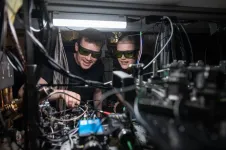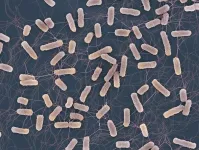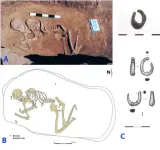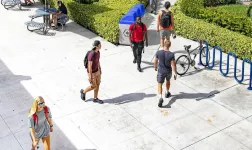Superconducting materials are similar to the carpool lane in a congested interstate. Like commuters who ride together, electrons that pair up can bypass the regular traffic, moving through the material with zero friction.
But just as with carpools, how easily electron pairs can flow depends on a number of conditions, including the density of pairs that are moving through the material. This “superfluid stiffness,” or the ease with which a current of electron pairs can flow, is a key measure of a material’s superconductivity.
Physicists at MIT and Harvard University have now directly measured superfluid stiffness for the first time in “magic-angle” graphene — materials that are made from two or more atomically thin sheets of graphene twisted with respect to each other at just the right angle to enable a host of exceptional properties, including unconventional superconductivity.
This superconductivity makes magic-angle graphene a promising building block for future quantum-computing devices, but exactly how the material superconducts is not well-understood. Knowing the material’s superfluid stiffness will help scientists identify the mechanism of superconductivity in magic-angle graphene.
The team’s measurements suggest that magic-angle graphene’s superconductivity is primarily governed by quantum geometry, which refers to the conceptual “shape” of quantum states that can exist in a given material.
The results, which are reported in the journal Nature, represent the first time scientists have directly measured superfluid stiffness in a two-dimensional material. To do so, the team developed a new experimental method which can now be used to make similar measurements of other two-dimensional superconducting materials.
“There’s a whole family of 2D superconductors that is waiting to be probed, and we are really just scratching the surface,” says study co-lead author Joel Wang, a research scientist in MIT’s Research Laboratory of Electronics (RLE).
The study’s co-authors from MIT’s main campus and Lincoln Laboratory include co-lead author and former RLE postdoc Miuko Tanaka, Thao Dinh, Daniel Rodan-Legrain, Sameia Zaman, Max Hays, Bharath Kannan, Aziza Almanakly, David Kim, Bethany Niedzielski, Kyle Serniak, Mollie Schwartz, Jeffrey Grover, Terry Orlando, Simon Gustavsson, Pablo Jarillo-Herrero, and William D. Oliver, along with Kenji Watanabe and Takashi Taniguchi of the National Institute for Materials Science in Japan.
Magic resonance
Since its discovery in 2004, graphene has proven to be a wonder substance of sorts. The material is effectively a single, atom-thin sheet of graphite consisting of a precise, chicken-wire lattice of carbon atoms. This simple configuration can exhibit a host of superlative qualities in terms of graphene’s strength, durability, and ability to conduct electricity and heat.
In 2018, Jarillo-Herrero discovered that when two graphene sheets are stacked on top of each other, at a precise, “magic” angle, the twisted structure — known as magic-angle twisted bilayer graphene, or MATBG — exhibits entirely new properties, including superconductivity, in which electrons pair up, rather than repelling each other as they do in everyday materials. These so-called Cooper pairs can form a superfluid, with the potential to superconduct, meaning they could move through a material as an effortless, friction-free current.
“But even though Cooper pairs have no resistance, you have to apply some push, in the form of an electric field, to get the current to move,” Wang explains. “Superfluid stiffness refers to how easy it is to get these particles to move, in order to drive superconductivity.”
Today, scientists can measure superfluid stiffness in superconducting materials through methods that generally involve placing a material in a microwave resonator — a device which has a characteristic resonance frequency at which an electrical signal will oscillate, at microwave frequencies, much like a vibrating violin string. If a superconducting material is placed within a microwave resonator, it can change the device’s resonance frequency, and in particular, its “kinetic inductance,” by an amount that scientists can directly relate to the material’s superfluid stiffness.
However, to date, such approaches have only been compatible with large, thick material samples. The MIT team realized that to measure superfluid stiffness in atomically thin materials like MATBG would require a new approach.
“Compared to MATBG, the typical superconductor that is probed using resonators is 10 to 100 times thicker and larger in area,” Wang says. “We weren’t sure if such a tiny material would generate any measurable inductance at all.”
A captured signal
The challenge to measuring superfluid stiffness in MATBG has to do with attaching the supremely delicate material to the surface of the microwave resonator as seamlessly as possible.
“To make this work, you want to make an ideally lossless — i.e., superconducting — contact between the two materials,” Wang explains. “Otherwise, the microwave signal you send in will be degraded or even just bounce back instead of going into your target material.”
Will Oliver’s group at MIT has been developing techniques to precisely connect extremely delicate, two-dimensional materials, with the goal of building new types of quantum bits for future quantum-computing devices. For their new study, Tanaka, Wang, and their colleagues applied these techniques to seamlessly connect a tiny sample of MATBG to the end of an aluminum microwave resonator. To do so, the group first used conventional methods to assemble MATBG, then sandwiched the structure between two insulating layers of hexagonal boron nitride, to help maintain MATBG’s atomic structure and properties.
“Aluminum is a material we use regularly in our superconducting quantum computing research, for example, aluminum resonators to read out aluminum quantum bits (qubits),” Oliver explains. “So, we thought, why not make most of the resonator from aluminum, which is relatively straightforward for us, and then add a little MATBG to the end of it? It turned out to be a good idea.”
“To contact the MATBG, we etch it very sharply, like cutting through layers of a cake with a very sharp knife,” Wang says. “We expose a side of the freshly-cut MATBG, onto which we then deposit aluminum — the same material as the resonator — to make a good contact and form an aluminum lead.”
The researchers then connected the aluminum leads of the MATBG structure to the larger aluminum microwave resonator. They sent a microwave signal through the resonator and measured the resulting shift in its resonance frequency, from which they could infer the kinetic inductance of the MATBG.
When they converted the measured inductance to a value of superfluid stiffness, however, the researchers found that it was much larger than what conventional theories of superconductivity would have predicted. They had a hunch that the surplus had to do with MATBG’s quantum geometry — the way the quantum states of electrons correlate to one another.
“We saw a tenfold increase in superfluid stiffness compared to conventional expectations, with a temperature dependence consistent with what the theory of quantum geometry predicts,” Tanaka says. “This was a ‘smoking gun’ that pointed to the role of quantum geometry in governing superfluid stiffness in this two-dimensional material.”
“This work represents a great example of how one can use sophisticated quantum technology currently used in quantum circuits to investigate condensed matter systems consisting of strongly interacting particles,” adds Jarillo-Herrero.
This research was funded in part by the US Army Research Office, the National Science Foundation, the Air Force Office of Scientific Research, and the Under Secretary of Defense for Research and Engineering.
A complementary study on magic-angle twisted trilayer graphene (MATTG), conducted by a collaboration between Philip Kim’s group at Harvard University and Jarillo-Herrero’s group at MIT, appears in the same issue of Nature.
###
Written by Jennifer Chu, MIT News
END





